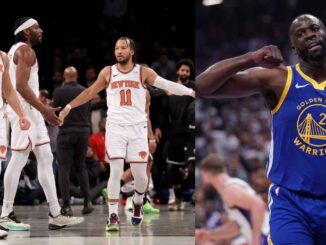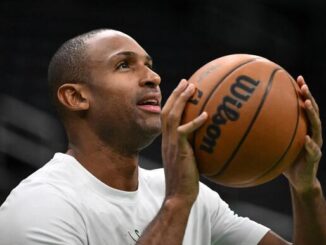
Giannis Antetokounmpo is out for at least a couple of weeks with a groin strain. Anthony Davis remains sidelined in Dallas with a calf strain. Victor Wembanyama is out with a strained calf. Wemby’s star teammates Stephon Castle (hip) and No. 2 pick Dylan Harper (calf) are out. Ja Morant is out with a calf strain.
If it feels like injuries to the NBA’s biggest names — especially soft tissue injuries — are on the rise, it’s because they are. The numbers are shocking, as Tom Haberstroh laid out at Yahoo Sports. (Note: He defines a star by using the NBA’s definition in its Player Participation Policy, an All-Star or All-NBA player within the past three years. There are 45 such players in the league.)
“All told, NBA stars have already missed over 200 games this season due to injury or illness, doubling the total we saw at this point two years ago … For a league fighting the image that star players aren’t playing enough, this season’s power outage is especially alarming. In 2023-24, with the first year of the midseason tournament seeming to motivate its biggest names to suit up, star players played 87.2% of its games by this juncture of the season (12 games in). Last season, it dipped to 82.6%. This season, the bottom has fallen out, with star participation falling to 67.6%.”
It’s worth noting that while star players are missing more games, overall injuries are not up, including soft tissue injuries.
The time lost for calf strains in the NBA is roughly 2-3 weeks, but 1:3 cases will miss more than 20 days and 1:5 cases will miss more than 30 days.
— Jeff Stotts (@InStreetClothes) November 17, 2025
What is different this year is that teams are being more cautious with their injured stars. Fresh in the minds of fans, team medical staffs, owners, and everyone else is the image of Tyrese Haliburton pounding the court during Game 7 of the NBA Finals, after trying to play through a sore calf and tearing his Achilles. Same with Jayson Tatum tearing his Achilles after playing through a sore calf. Same with Damian Lillard, who is out this season after tearing his Achilles while playing through a sore calf.
The volume of injuries to stars is real and concerning.
Steve Kerr concerned
The rise in injuries has drawn the attention of a lot of people, including Golden State coach Steve Kerr. He blamed a combination of the increased pace of play around the league, the increased spacing in today’s game, and the relentlessness of the NBA’s 82-game schedule for the rise.
“I’m very concerned. It’s dramatic — the pace difference is dramatic…” Kerr said Tuesday, via NBC Sports Bay Area. “I think across the league, everybody understands now that it’s just easier to score if you can beat the opponent down the floor, get out in transition. But when everybody’s doing that, the games are much higher-paced, faster-paced, and then everyone has to cover out to 25 feet, because everybody can shoot 3s.
“So we have all the data players are running faster and further than ever before, and so we’re trying to do the best we can to protect them, but basically, have a game every other night and not an easy thing to do.”
Kerr isn’t the only coach thinking that way.
“I would agree with Steve,” Utah Jazz coach Will Hardy said. “The tempo of the game is quick, and I think you’re seeing, even this year, I think there’s 25 teams in the NBA that are averaging 100 possessions a game [Note: it is 24], and last year there were 12 [13]. So you’re seeing an uptick in the pace of the game, it seems like over the last couple of years.”
The median pace of an NBA game is 101.5 possessions per team, per game this season. That is up from 99.6 last season, and 96.6 10 years ago (when only two teams had a pace over 100 for the season). That increased pace doesn’t just impact offense.
“I think if you ask any coach in the NBA what’s the first key to any game, it’s literally getting back on defense, and the numbers back that up,” Lakers coach J.J. Redick said.
Increased spacing an issue
Shooting and spacing are everything in today’s NBA, but that means more ground for defenders — and tired leg and calf muscles — to cover. Defenders are now asked to collapse down in a help situation to protect the paint, then race back out and contest a shot at the arc (or, they are zoning off the weak side as the rest of the defense collapses, and they have to be able to move to challenge multiple players). That kind of explosive movement can be hard on muscles and put pressure on tendons and ligaments. Not to mention a game where Euro-steps, deceleration moves and more put more strain on a player’s body.
All that has changed over the years.
“When I was in Orlando (2006-13), I could play through injuries all the time because it was just, it was easy to do based on the way the game was played,” said Redick, who played 15 years in the league before retiring. “And then by year 14-15, you’re going to have to guard crazy stuff on every possession, and it’s just too much movement, and if you’re second-guessing your body, you’re not an effective player.”
What was different about the game?
“[When I] first got in the league, there were two bigs, and you go against Memphis, and you’re playing against Zach Randolph and Marc Gasol,” Redick said. “And then the stretch four — God bless, RIP, doesn’t exist anymore — that was a short-lived thing. And then I think over the last eight to 10 years it’s really evolved as teams have spread you out more and gotten to more movement, more multiple actions, and more pace.”
That’s not changing. If anything, the pace of the game is going to increase and shooters will have to be covered further out. Another trend this season — popularized by the Pacers a season ago on their run to the Finals — is pressuring the ball handler for 94 feet up the court, adding more wear and tear to bodies.
There are no easy answers here. Kerr is among those who would like to see 10 fewer (or more) games on the NBA schedule each year, but he also understands the reality.
“The tricky part is everyone, all the constituents, would have to agree to take less revenue,” Kerr said. “And 2025 in America, good luck getting any industry to agree [to that].”
The best teams can do right now is focus on recovery between games, monitor the situation, get players rest when needed, and take care of injured players, not push them to get back on the court.
But all of that is going to mean years like this one, where a month into the season, a lot of stars are sidelined.



Be the first to comment